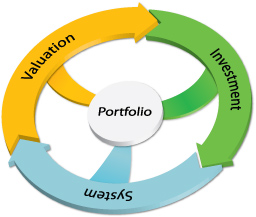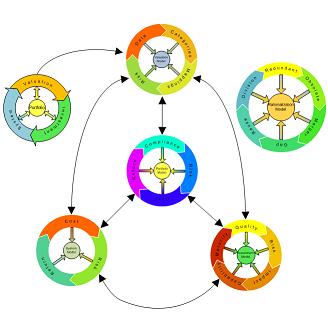The Zifian® Portfolio Rationalization Process
Portfolio Rationalization is carried out in a series of steps starting with a snapshot of the investments and culminating with recommendations for rationalization. Figure 1 shows the series of high-level phases in the process of portfolio rationalization. However, it should be understood that these phases do not need to be strictly sequential. Rather, they may be performed in parallel and potentially in different orders.
Portfolio rationalization is divided into four main phases. Each of these high-level phases is broken down to more detailed processes. Figure 2 shows a diagram indicating some more detailed processes in the Portfolio Rationalization Process. The high-level phases and their processes are explained following below.
Each of the four main phases culminates in a mathematical model used to quantify the business value for the phase. The Valuation phase yields the Valuation Model, the Investment phase provides the Investment Model, the System Phase gives the System Model, and the Portfolio phase has the Portfolio Model. Each of these models examines a separate aspect of the valuation of the portfolio. In addition, the Rationalization Model examines the portfolio of investments to identify rationalization targets and organizational best practices.
The Portfolio Rationalization Lifecycle
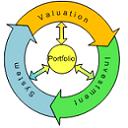
The Portfolio Rationalization Lifecycle encapsulates the entire portfolio rationalization process. The process is a continuous, ongoing operation, not a linear procedure. Information enters the lifecycle as raw data in the Valuation phase, then proceeds to the Investment phase, then the System phase, and finally the Portfolio phase.
The Valuation Model
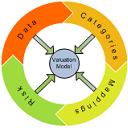
The Valuation Model analyzes the available raw investment information to produce a set of mathematical models that may be used to compute the business value of the investments. The Valuation Model does not compute the actual business values. Instead, this model provides the fundamental mathematical relations that may be used to compute business value.
The Investment Model
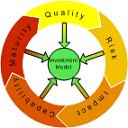
The Investment Model uses the results from the Valuation Model to compute the business value for each of the investments. The Investment Model provides a mathematical relationship to compute every identified business value for each of the investments. This model is fundamental to the portfolio rationalization process.
The System Model

The System Model examines the investments at a system level. Investments may be grouped together for a coherent purpose similar to how a set of projects may form a program. When a group of investments is choreographed to together as a whole, the overall value of the system may be greater than the sum of its parts. The System Model examines this and provides mathematical models to identify the additional benefits the system of investment obtains in excess of the sum of the constituent investments.
The Portfolio Model
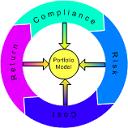
The Portfolio Model reviews the portfolio as a whole and identifies additional value from the alignment of the individual investments and systems with the strategic direction of the portfolio. The alignment of the investments with the strategic direction can produce additional value for the portfolio.
The Rationalization Model
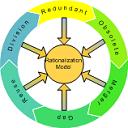
The Rationalization Model uses the results of the previous models to create a system of rules used to determine which investments require rationalization. In addition to these rationalization targets, the Rationalization Model identifies organizational best practices. This information may be used to drive the entire portfolio toward increasing levels of efficiency and value.
